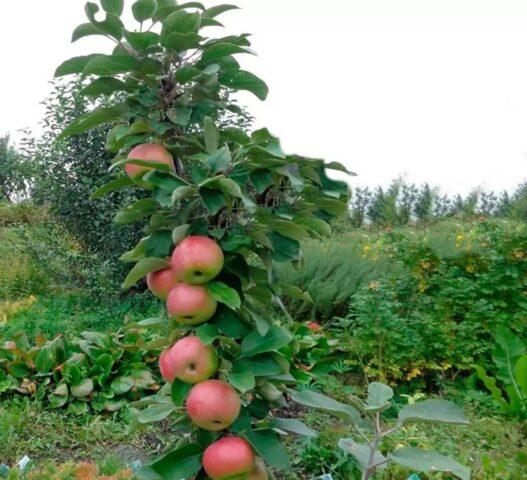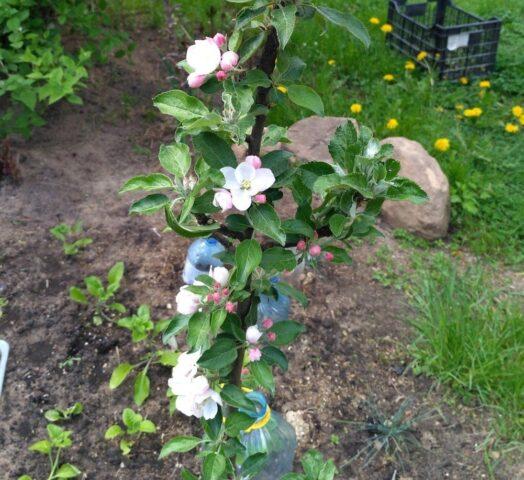Content
- 1 History of selection
- 2 Description of the Ostankino columnar apple tree
- 3 Characteristics of the Ostankino columnar apple tree
- 4 Advantages and disadvantages
- 5 How to plant an Ostankino apple tree
- 6 Care instructions
- 7 Collection and storage
- 8 Conclusion
- 9 Reviews from gardeners about the Ostankino apple tree
The Ostankino columnar apple tree belongs to the category of time-tested varieties, the cultivation of which does not cause difficulties even for novice gardeners. The species is also characterized by excellent fruit taste and unpretentiousness to growing conditions. These qualities allow the Ostankino apple tree to remain relevant, despite the emergence of new columnar species. However, in order for it to show maximum performance, it is necessary to plant and provide care taking into account its characteristics.

Ostankino - the first domestic variety of columnar apple tree
History of selection
This type of culture was developed back in Soviet times, namely in 1974. Selection work was carried out at the Institute of Horticulture, located in Moscow, namely in the Biryulyovo Vostochny district. The author of the variety is the head of the department of selection and genetics V.V. Kichina.The goal of the creation was to obtain a variety with a compact crown, high vitality, good yield and excellent taste.
The Ostankino apple tree was based on the following species: Vazhak and Obilnoe. The resulting seedling was able to absorb the best qualities of its ancestors, and surpass them in characteristics. Based on the results of successful variety trials, this species was included in the State Register in 2002.
Description of the Ostankino columnar apple tree
Externally, the Ostankino apple tree is radically different from standard types of crop. This makes it possible to accurately determine compliance with the variety.
Crown
According to the breeder’s description, the columnar Ostankino apple tree is a medium-sized, small-sized and compact tree, the height of which reaches 2.5 m. The trunk is strong and thick, which during the growing season is densely covered with ringlets, fruitlets and, less often, spears. The crown is well leafy, but the diameter of its growth is only 40-50 cm. The wood of the Ostankino apple tree is highly durable. It easily withstands the load during the fruiting period and does not bend from strong gusts of wind.
The shoots are thickened, covered with gray-brown bark, without edges. Their internodes are short. The buds of the Ostankino apple tree are small, wide-conical, and gray-conical in color.
The leaves are obovate, 12-14 cm long and about 6 cm wide. The plates are flattened, smooth, dark green in color, with jagged edges and moderate venation. The petioles are short, thickened, with anthocyanin at the base. Stipules are narrowly ovate with a dissected edge, of medium length.
The buds are small, simple, consisting of five elongated tuberculate corrugated petals of a white-pink hue.The flowering period begins in the second half of May.

The annual growth of the Ostankino apple tree is 5-10 cm
Fruit
Apples are round, one-dimensional, slightly flattened, symmetrical. Their average weight is 100-150 g, but there are specimens weighing 250-300 g. The main color of apples is greenish-yellow, the outer color is red-violet, occupying 2/3 of the part. The skin is thin and dense. Seed chambers are closed type. The stalks are short and there is no axial cavity. When you cut an apple, you can see fine-grained, juicy, white flesh.
The fruits are placed evenly and closely on the trunk. They are formed already at a height of 35-40 cm from the soil level.
Characteristics of the Ostankino columnar apple tree
To assess the productivity of the Ostankino variety and compare it with other columnar crop species, it is necessary to study its characteristics. This will also allow you to find out what growing conditions are optimal for a given apple tree.
Taste qualities
The taste of the fruits of the Ostankino variety is balanced, dessert. Sweetness predominates in it, but there is also a slight sourness. Apples are suitable for fresh consumption and processing. The tasting rating of the variety is 4.3 points out of a possible 5.

When ripe, the fruits emit a pleasant, mild aroma.
When does the Ostankino columnar apple tree ripen?
The columnar Ostankino apple tree has an average fruit ripening period. Harvesting is recommended in early to mid-September, depending on the growing region. Although the Ostankino variety is not inferior to winter crops in terms of shelf life. If the conditions are met, the harvested crop retains its consumer properties until December.
Productivity
This columnar apple tree is early bearing. Already in the second year of planting it bears its first fruits. And when reaching the age of five years, the harvest volume is 7-9 kg. But with proper care, this level can be doubled.

The Ostankino columnar apple tree bears fruit annually
Frost resistance
This tree has an average level of frost resistance. The apple tree does not suffer from temperatures dropping to -25 °C. Therefore, when grown in central regions, it overwinters well.
Pollinators
The Ostankino apple tree is self-pollinating. Therefore, it does not require close placement of pollinating trees. This explains the high level of fruit set.
Growing regions
The Ostankino columnar apple tree variety is promising for the Non-Black Earth Region and the Black Earth Center. It has become widespread in central Russia, where it shows high productivity. Most often, the columnar apple tree can be found in dachas and garden plots in the Moscow region. Perm and Samara regions.
Disease resistance
According to the characteristics of the variety, the Ostankino columnar apple tree has increased resistance to scab, as well as other common fungal diseases of the crop. It is also less susceptible to pests. However, inappropriate growing conditions increase the likelihood of damage. Therefore, experienced gardeners recommend not to ignore preventive treatments.
Advantages and disadvantages
The Ostankino homemade columnar apple tree has many advantages, which allows it to withstand competition with new species. But it also has certain disadvantages that you need to pay attention to when choosing this variety.

The life potential of the Ostankino apple tree is 15 years
Main advantages:
- compact size;
- precociousness;
- high productivity;
- excellent presentation;
- dessert taste;
- resistance to diseases and pests.
Flaws:
- wood quickly becomes obsolete;
- increased cost of seedlings.
How to plant an Ostankino apple tree
For the full development and abundant fruiting of the autumn columnar Ostankino apple tree, it is necessary to plant it correctly. The best option is one-year-old seedlings, as they quickly adapt to a new location. It is necessary to purchase planting material from nurseries and specialized stores. When purchasing, you need to inspect the seedling. It should have no signs of diseases or pests, and the root system should be well developed.
For the Ostankino columnar apple tree, you need to choose an open sunny area, protected from cold gusts of wind. It is important that the soil is loose and nutritious. The best option is loam with a neutral acidity level.
Two weeks before planting, it is necessary to prepare a hole measuring 60 by 60 cm. It is recommended to fill it with a nutritious soil mixture consisting of turf, sand, peat, humus in a ratio of 2:1:1:1. You also need to additionally add 50 g of superphosphate and 40 g of potassium sulfide, and then thoroughly mix the fertilizers with the soil.
Algorithm of actions:
- Make a slight elevation in the center of the hole.
- Place the seedling on it, carefully straighten the roots.
- Water the apple tree.
- Sprinkle the roots with soil and fill all the voids.
- Compact the soil surface at the base.
Care instructions
The Ostankino apple tree requires more careful care than standard types of crops. Therefore, when choosing it, this must be taken into account.
It is recommended to water the tree regularly 2-3 times a week in case of prolonged absence of rain. To do this, you can use settled water at a temperature of +18-22 °C. Moistening should be carried out in the evening by wetting the soil in the root circle up to 10 cm. During dry periods, it is recommended to place straw mulch in the root circle to prevent the formation of a crust on the surface of the soil and maintain air access to the roots.
Early and regular fruiting of the variety requires a sufficient amount of nutrients. Therefore, you need to fertilize the Ostankino apple tree three times a season. It is recommended to apply subcortex for the first time in the spring at the beginning of the growing season, using urea at the rate of 30-80 g, depending on the age of the plant.
It is necessary to fertilize the Ostankino apple tree a second time after flowering. During this period, it is important to use nitroammophoska at the rate of 30-70 g per tree. And the third feeding is recommended during fruit growth. During this period, it is necessary to use superphosphate 50-100 g and potassium sulfide 40-80 g per apple tree. It is also recommended to place humus in the root circle of the Ostankino apple tree in a layer of up to 10 cm in late autumn.
In young seedlings, it is necessary to normalize the load in order to increase their life potential. Therefore, in the first season it is necessary to remove all the flowers on the apple tree. In the second year, you can leave no more than five buds. In the future, it is recommended to constantly monitor the amount of ovary, which will allow you to grow large apples.

Each fruiting branch should have no more than 2-3 flowers
For the columnar Ostankino apple tree, the correct formation of the crown is important. It must be taken into account that there must be one barrel. When 2-4 shoots appear at the top of the tree, you need to select the strongest one and remove the rest.
In the first year after planting the Ostankino columnar autumn apple tree, you need to shorten the side shoots to two buds. In the second and third seasons, it is recommended to leave a whole branch growing horizontally, and cut the shoots located closer to the main conductor to two buds. Similarly, form fruit links up to five years old. And then cut them off at the trunk, exposing the lower part of the apple tree. Pruning should be done in early spring before the growing season begins or in the fall after it ends.
The Ostankino apple tree needs to be insulated for the winter to maintain its growth point. To do this, it is necessary to wrap the tree crown with spandbond in several layers. Carry out the procedure before frost sets in.
Collection and storage
Harvesting must be done in the morning in dry weather. For long-term storage, it is recommended to cut off the apples with scissors. It is recommended to place them in cardboard boxes, overlaying the layers with paper. You need to preserve the harvest at a temperature of +2-4 °C and a humidity of about 70% in a dark room so that it lasts as long as possible.

You cannot wash or wipe fruits before storing them.
Conclusion
The Ostankino columnar apple tree is ideal for growing in small garden plots, as it is characterized by a compact crown. But at the same time it gives a generous harvest every year. However, when growing it, it is necessary to control the load on the tree so that the fruits are large.It is also worth considering that the variety needs frequent updating, since it has a shorter viability period than standard types of crop.
Reviews from gardeners about the Ostankino apple tree








